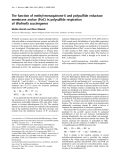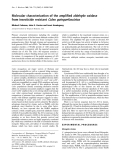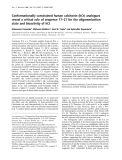
MINIREVIEW
Hyaluronan matrices in pathobiological processes
Aimin Wang
1
, Carol de la Motte
2
, Mark Lauer
1
and Vincent Hascall
1
1 Department of Biomedical Engineering, The Cleveland Clinic, Cleveland, OH, USA
2 Department of Pathobiology, The Cleveland Clinic, Cleveland, OH, USA
Mechanism of hyaluronan synthesis
Hyaluronan (HA) is a glycosaminoglycan that is syn-
thesized by a distinctly different mechanism from the
other glycosaminoglycans (chondroitin sulfate, heparan
sulfate, keratan sulfate). A diagram showing the mech-
anism of HA synthesis is given in Fig. 1. Hyaluronan
synthase (HAS) enzymes are synthesized in the endo-
plasmic reticulum (ER) in an inactive form and must
be transported in vesicles to and through the Golgi for
insertion into the plasma membrane. After the enzyme
has been activated, it utilizes the cytosolic substrates,
UDP-glucuronate (UDP-glcUA) and UDP-N-acetyl-
glucosamine (UDP-glcNAc), and adds them alternately
to the reducing end of the chain with release of the
anchoring UDP. The elongating chain is extruded into
the extracellular compartment. Confocal microscopy
images of live cells that were transfected with green
fluorescent protein (GFP)-HAS3 are shown in Fig. 1
[1]. The localization of the enzyme (green) in perinucle-
ar regions (ER ⁄Golgi) and in transport vesicles is
apparent. The active enzyme in the plasma membrane
(yellow) extrudes HA into the normal extracellular
fuzzy coats (red) with which monocytes do not interact
[2] (see accompanying article by Tammi et al. [3]).
This mechanism of HA synthesis has several unique
features [4]: (a) the extruded chain is not modified by
the addition of sulfoesters or epimerases that modify
other glycosaminoglycans; (b) the final chain can be
extremely large, > 10 million Da; (c) a core protein is
Keywords
autophagy; CD44; diabetes; diabetic
nephropathy; endoplasmic reticulum stress;
golgi; hyaluronan; hyaluronan synthase
proteoglycan synthesis; inflammation
Correspondence
A. Wang, Department of Biomedical
Engineering ⁄ND20, Lerner Research
Institute, The Cleveland Clinic, 9500 Euclid
Ave., Cleveland, OH 44195, USA
Fax: 216 444 9198
Tel: 216 445 3237
E-mail: wanga@ccf.org
(Received 1 November 2010, revised 9
February 2011, accepted 25 February
2011)
doi:10.1111/j.1742-4658.2011.08069.x
Hyaluronan matrices are ubiquitous in normal and pathological biological
processes. This remarkable diversity is related to their unique mechanism
of synthesis by hyaluronan synthases. These enzymes are normally acti-
vated in the plasma membrane and utilize cytosolic substrates directly to
form these large polyanionic glycosaminoglycans, which are extruded
directly into the extracellular space. The extracellular matrices that are
formed interact with cell surface receptors, notably CD44, that often dic-
tate the biological processes, as described in the accompanying minireviews
of this series. This article focuses on the discovery in recent studies that
many cell stress responses initiate the synthesis of a monocyte-adhesive
hyaluronan extracellular matrix, which forms a central focus for subse-
quent inflammatory processes that are modulated by the dialogue between
the matrix and the inflammatory cells. The mechanisms involve active hyal-
uronan synthases at the cell membrane when cell stresses occur at physio-
logical levels of glucose. However, dividing cells at hyperglycemic levels of
glucose initiate the synthesis of hyaluronan in intracellular compartments,
which induces endoplasmic reticulum stress and autophagy, processes that
probably contribute greatly to diabetic pathologies.
Abbreviations
CD44, cluster of differentiation 44; ER, endoplasmic reticulum; galNAc, N-acetylgalactosamine; GFP, green fluorescent protein; glcUA,
glucuronate; glcNAc, N-acetylglucosamine; HA, hyaluronan; HAS, hyaluronan synthase; PKC, protein kinase C.
1412 FEBS Journal 278 (2011) 1412–1418 ª2011 The Authors Journal compilation ª2011 FEBS

























